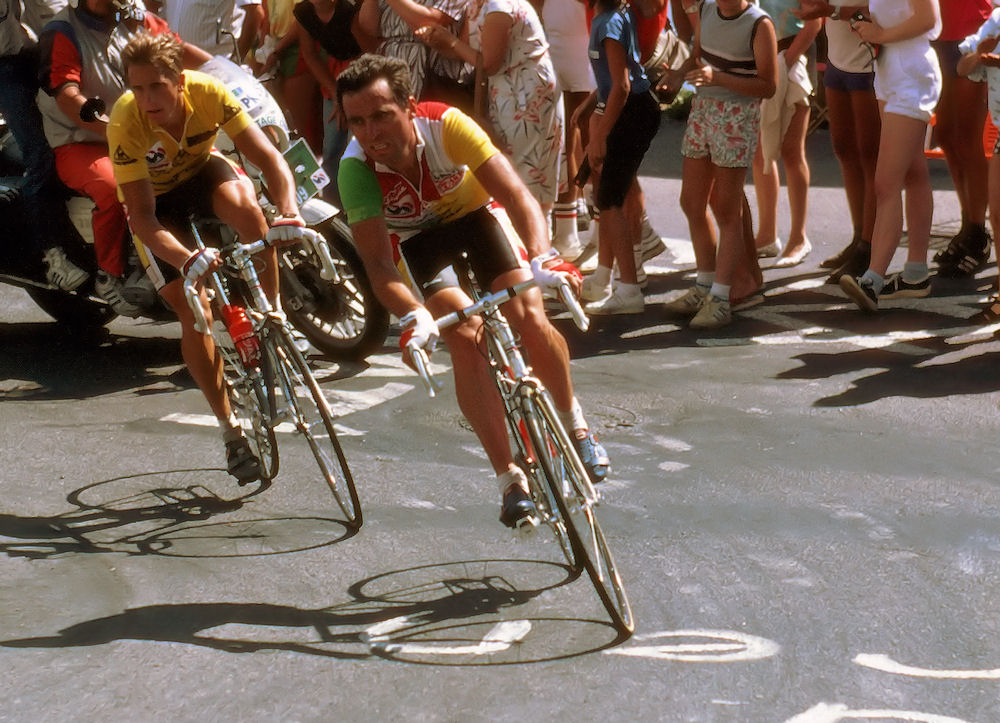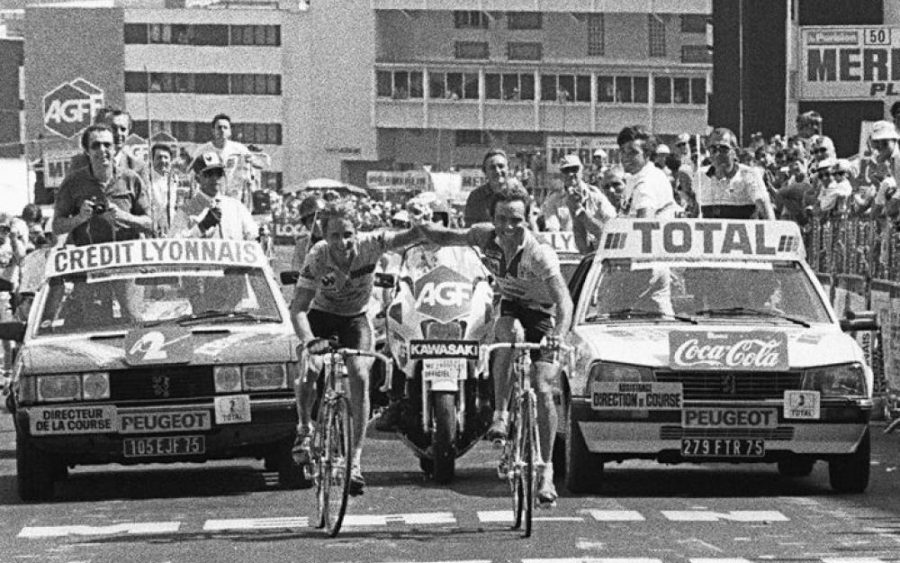Since its introduction to the Tour de France in 1952, Alpe d’Huez has been the scene of many legendary moments in cycling history. Among the most memorable is the iconic 18th stage of the 1986 Tour,
when Bernard Hinault and Greg LeMond reached the summit hand in hand,
in a symbolic gesture that belied the tensions brewing between the two teammates.
Hinault-LeMond rivalry – 1985 edition
During the mid-1980s, Team La Vie Claire boasted a formidable lineup, particularly in the Tour de France. Bernard Hinault, one of cycling’s greatest figures, had already won the Tour five times (in 1978, 1979, 1981, 1982, and 1985), making him the second French rider, after Jacques Anquetil, to achieve such an incredible result.1
In 1985, it was clear that the team was built around helping Hinault secure his fifth victory. However, the road to that triumph was not without difficulty. In the 14th stage,
Hinault suffered a serious crash,
breaking his nose and compromising his performance in the subsequent stages.
Most notably, during the 17th stage, Hinault began to struggle and lost ground, while Greg LeMond, his younger American teammate, was ordered not to work with Stephen Roche, who had positioned himself for a possible attack that could have bolstered LeMond’s chances both for the stage win and in the overall standings. Roche, overhearing the instructions from the La Vie Claire team car, capitalized on the situation and rode to victory, leaving LeMond frustrated by his team’s decision and missing an opportunity to strengthen his standing in the race
Despite the setback, Hinault retained the yellow jersey all the way to Paris, while LeMond, who had contemplated abandoning the race in frustration, was persuaded to stay and ultimately finished second.
And again in 1986
Ahead of the 1986 Tour de France, Hinault publicly promised to support LeMond in his quest for victory, recognizing the young American’s talent and believing it was his turn to lead the team. Yet as the race progressed,
there were growing signs that Hinault’s promise might not be entirely sincere.
His aggressive riding and frequent attacks suggested he still harbored ambitions of winning a sixth Tour, creating tension between the two riders.
The conflict reached its peak on the 17th stage, where Hinault cracked on the Col d’Izoard, losing his lead in the general classification. LeMond seized the opportunity, taking over the yellow jersey and becoming the first American to lead the Tour de France. Hinault’s role, however, remained ambiguous. Although they were teammates, it was clear that Hinault and LeMond were now rivals in all but name.
Hand in hand on the top of Alpe d’Huez
The very next day, the Tour arrived at Alpe d’Huez for what would become one of the most famous stages in its history. The grueling 162.5 km route began in Briançon, with the peloton facing the punishing climbs of Col du Galibier, the descent through Col du Télégraphe, and the relentless ascent of Col de la Croix de Fer, before the final test at Alpe d’Huez.

Bernard Hinault launched multiple accelerations in the early part of the stage, with a particularly strong attack before reaching Col du Télégraphe, putting the group of favorites under pressure. At the same time, Greg LeMond received instructions to focus on attacking Urs Zimmermann, who was second in the overall standings, rather than collaborating with him to close the gap to Hinault (and other riders in his breakaway group but with lesser importance).
LeMond succeeded in creating a gap between himself and Zimmermann before the ascent of Col de la Croix de Fer began. He also managed to bridge across to the breakaway trio at the front of the race
As the stage wore on, the breakaway group dwindled until only Hinault and LeMond remained, locked in a tense duel. The legendary climb up Alpe d’Huez, with its 21 hairpin bends, provided the perfect setting for this dramatic showdown between teammates-turned-rivals.

As they neared the finish, LeMond, showing a measure of respect and solidarity, reached out to Hinault. In a gesture that would become iconic, he put his arm around the Frenchman and exchanged a few words. Hinault, ever the showman, took LeMond’s hand, and together they crossed the line,
with Hinault taking the stage win by a split second.
This moment, immortalized in countless photographs, captured the complexity of their relationship—a delicate balance between rivalry and mutual respect. Although they appeared united at the finish, their relationship had been strained throughout the race, with LeMond having to overcome not just his opponents, but also the uncertainty of Hinault’s true intentions. Despite the tensions, LeMond went on to win the 1986 Tour de France, becoming the first American to do so.
For Hinault, it was the last Tour de France of his illustrious career, but his final act on Alpe d’Huez ensured his legacy as both a fierce competitor and a legend of the sport.
- Only our cyclists achieved the 5-time triumph, besides Jacques Anquetil and Bernard Hinault, also Eddy Merckx and Miguel Indurain. [↩]